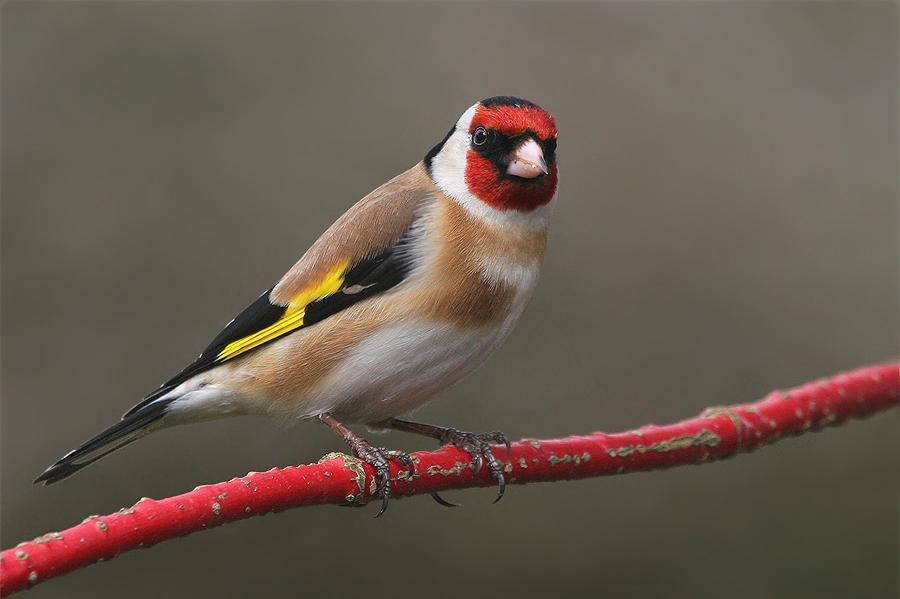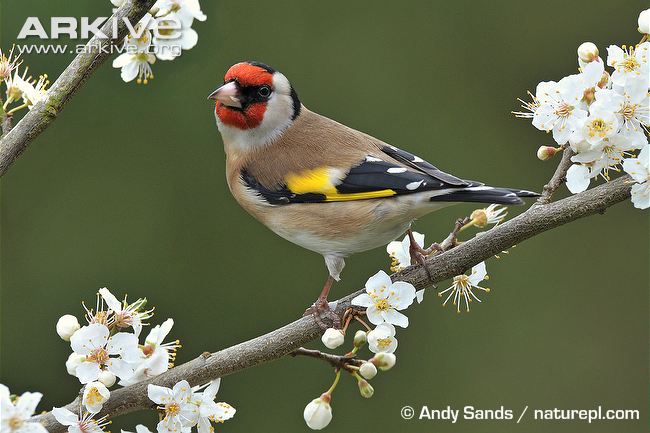
Carduelis carduelis
SUBFAMILY
Carduelinae
TAXONOMY
Carduelis carduelis Linnaeus, 1758. Ten subspecies are recognized.
OTHER COMMON NAMES
English: Goldfinch; French: Chardonneret йlйgant; German:
Stieglitz; Spanish: Jilguero Europeo.
PHYSICAL CHARACTERISTICS
European goldfinches are 5–6 in (13–15 cm) in body length.
They have a sharply pointed beak, and a forked tail. The back
is colored dark olive-brown, the wings are black with a yellow
patch, the tail black, the belly whitish, and the face is red, bordered
with white and black. Females are olive-brown with yellow
highlights and darker wings and tail.
DISTRIBUTION
European goldfinches range over almost all of Europe, the
Azores, the Canary Islands, and as far east as western Russia.
They have also been introduced to a few places in the United
States, Central America, and Australasia, where they survive in
urbanized areas.
HABITAT
European goldfinches inhabit open woodlands, shrubby areas,
orchards, parks and gardens, and well-vegetated cultivated areas.
BEHAVIOR
The European goldfinch has a distinctive bounding flight. It is
a migratory species, breeding in northern parts of its range and
spending the winter in southern reaches. It is a highly social
bird, particularly during the non-breeding season when it occurs
in flocks, often with other finches. The courtship and territorial
displays include aerial maneuvers and singing by the
male. The song is a high-pitched twittering, and there are also
distinctive call notes. They often position and hold food using
their toes.
FEEDING ECOLOGY AND DIET
The European goldfinch feeds on small seeds and grains, particularly
favoring species in the aster family, such as dandelions,
thistles, burdock, lettuce, and sunflowers. The young are
fed partly with insects.
REPRODUCTIVE BIOLOGY
The European goldfinch builds a small, neat, cup-shaped nest
of woven grass, moss, and lichens. Typically, the nest is positioned
at the end of a small branch in an open-grown tree or
shrub. They breed twice or sometimes three times each year,
with each clutch consisting of four to five eggs. In general, relatively
warm, dry summers result in greater reproductive success
than those with cool, wet weather.
CONSERVATION STATUS
Not threatened. The European goldfinch suffered widespread
population declines over parts of its range during the 1800s because
of uncontrolled live-trapping for the commercial pet
trade. Their population has since recovered, however, and they
are now a widespread and abundant species.
SIGNIFICANCE TO HUMANS
European goldfinches are well-known and popular birds. They
can be tamed and have been kept as caged songbirds, although
this is now uncommon. In the past, they provided amusement
for people, who provided the birds with food tied to the end of
a hanging thread. The bird would grasp the thread with its
beak, pull up a section, hold it with its foot, and continue to do
this until it had pulled up the food. European goldfinches are
so good at this trick that for centuries they were kept in special
cages constructed so that the birds could only survive by
pulling up and holding onto threads, one of which provided
seed and the other a thimble containing water. In the sixteenth
century, this contraption was so popular in parts of Europe
that the birds were commonly known as “dippers.”
Photo Gallery of - European goldfinch




 Animalia Life
Animalia Life